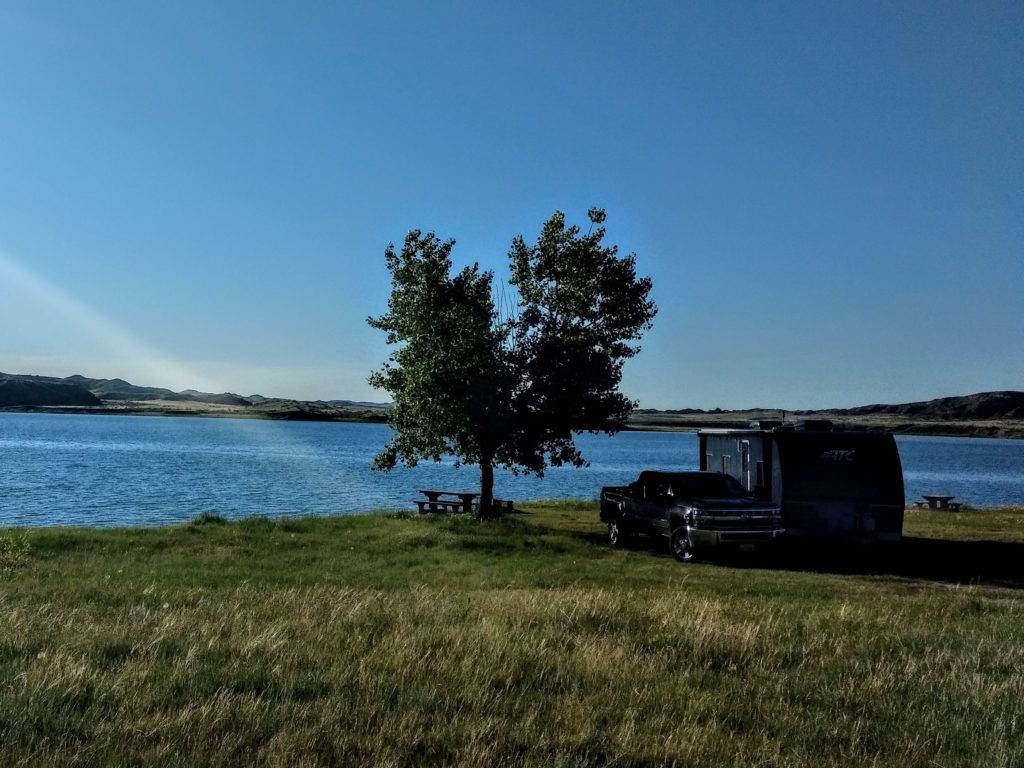You may have heard that there is a rule prohibiting camping within 200 feet from a body of water. This rule has been printed in camping guidelines issued by the Bureau of Land Management, the U.S. Forest Service, the National Park Service, the U.S. Fish & Wildlife, and even the Army Corps of Engineers. But where did this rule come from? Where is it codified in the U.S. Code or Code of Federal Regulations?

The 200 Feet Water Setback Rule for Camping
The rule states that you cannot camp right up close to a body of water, be it a lake, pond, stream, river, or other. You have to keep your camp at least 200 feet away. This goes for tent campers, RVers, and even folks just throwing a sleeping bag on the ground.
The interesting thing is that the BLM, USFS, NPS, and other federal land management agencies, have actually built developed campgrounds right up close to the water, well within the 200 feet limit. How, therefore, is it legal?
Origins of the 200 Feet Rule
The rule came about during the 1990s, when the Leave No Trace Center for Outdoor Ethics, the actual non-profit organization stewarding the “Leave No Trace” movement, adopted its “Seven Principles”. These principles serve as a suggestion to outdoor enthusiasts on how they should behave with respect to the environment. The 200 feet setback rule is part of the Seven Principles.
The setback rule was intended to keep pollutants out of lakes and streams, provide wildlife with free access to water, and to maintain visual beauty.
It’s important to understand that Leave No Trace is not a government agency. It has no regulatory authority. It’s just a private group trying to raise environmental awareness. However, it has managed to gain the respect of federal land management agencies.
How Do Federal Land Management Agencies Enforce This Rule?
Federal land management agencies do not enforce the 200 feet setback rule from a nationwide standpoint. Instead, what these agencies do is post signs, print flyers, and produce video encouraging people to apply all of the “Seven Principles” when visiting public lands.
In 2009, the US Forest Service (USFS), Bureau of Land Management (BLM), US Fish and Wildlife Service (USFWS), National Park Service (NPS), and the Army Corp of Engineers (ACOE), all signed a Memorandum of Understanding (read the MOU here) with the Leave No Trace Center for Outdoor Ethics to adopt its Seven Principles. The adoption was not to enforce the principles as rule, but to simply create educational materials for visitors.
These agencies, however, have published camping guidelines that are in conflict with the Memorandum of Understanding. In some cases, they make it seem as if the Seven Principles are actual federal laws. In other cases, agencies have violated the Seven Principles by building campgrounds right up close to the water’s edge.
Does the 200 Feet Rule exist as law or regulation anywhere on a Federal Level?
No, not at the federal level.
That is, none of the above mentioned federal land management agencies have codified the 200 feet rule into U.S. Code or the U.S. Code of Federal Regulations. As far as the nation as whole is concerned, the Seven Principles of Leave No Trace is simply a suggested practice.
However, all federal land management agencies have its own rules regarding sanitation when visiting public lands…
- BLM rule § 8365.1-1, “Sanitation”, makes it a violation to, “Pollute or contaminate water supplies or water used for human consumption;”
- USFS rule § 261.11 “Sanitation”, makes it a violation of, “Placing in or near a stream, lake, or other water any substance which does or may pollute a stream, lake, or other water.”
- NPS rule § 2.14 “Sanitation and Refuse”, prohibits, “Polluting or contamination park area waters or water courses”.
- BOR rule § 423.34 “Sanitation”, requires, “You must not bring or improperly dispose of refuse on Reclamation facilities, lands, and waterbodies. Both the owner and the person bringing or disposing refuse may be issued a citation for violating this provision.”
- ACOE rule § 327.9 “Sanitation” state that, “The spilling, pumping, discharge or disposal of contaminants, pollutants or other wastes, including, but not limited to, human or animal waste, petroleum, industrial and commercial products and by-products, on project lands or into project waters is prohibited.”
- USFWS rule § 27.94 “Disposal of Waste” states that, “The littering, disposing, or dumping in any manner of garbage, refuse sewage, sludge, earth, rocks, or other debris on any national wildlife refuge except at points or locations designated by the refuge manager, or the draining or dumping of oil, acids, pesticide wastes, poisons, or any other types of chemical wastes in, or otherwise polluting any waters, water holes, streams or other areas within any national wildlife refuge is prohibited.”
It’s possible you may hear a law enforcement officer with one of the above agencies asking you to move your camp at least 200 feet back from the water. However, what he or she is actually saying is that you could be in violation of one of the above rules, and that moving 200 feet back is his or her recommended solution.
Why Are There Developed Campgrounds Right Up Close to the Water?
Because the 200 feet setback rule is not an actual federal law or regulation.
This allows land management agencies to still create highly desirable campgrounds right along beaches, lakes, and riverbanks. Even though these agencies have signed a Memorandum of Understanding with Leave No Trace, they only abide by it on a selective basis. State and federal politicians encourage agencies to build these campgrounds in defiance of Leave No Trace because it brings tourist dollars to their state. And campers do indeed pay a lot of money to reserve these sites.
Yet at the same time, agencies will ask boondockers to stay away from the water’s edge.
Individual Parks, Forests, and Field Offices May Adopt Specific Rules
Even though the 200 feet setback rule is not actual federal law or regulation, individual parks, forests, and field offices are still free to adopt it as official policy for their local areas.
The BLM, for example, is broken out into State offices, and Local Field Offices. The BLM does allow each state office and local field office to establish its own rules. Hence, it’s possible that a local BLM field office may adopt the 200 feet rule as an official rule. It must post this rule on a sign at or near each affected area, and publish it in the Federal Register, as well as a local newspaper.
Some national forests have adopted this rule, and have made it enforceable, but have defined different buffers. For example, the White River National Forest in Colorado have adopted this rule, but with a 100 foot limitation (see their Recreation Guide, Page 2, sidebar).
The State of Arizona has adopted something that affects all state lands, but made it more extreme, forcing campers at least 1/4 mile away (see ARS § 17-308 Unlawful camping). Federal agencies operating in Arizona, except for the National Park Service, will recognize the state setback.
The only way to truly know what the rules are, is to contact the local field office, national park, national forest, etc. and ask.


I’m interested in rules for grey water on private property. I want to know if grey water can be used to water fruit trees & or garden when on 3+ acres of private property.